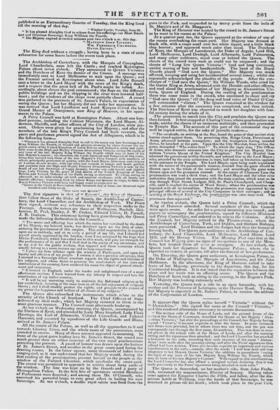It appears that the Queen styles herself " Victoria" without
the " Alexandrina." She signed her name at the Council " Victoria; " and this rendered alterations necessary in certain documents.
" The written rolls of the House of Lords, and the printed forms of the o ohs at the blouse of Commons, described the Queen as her Majesty Alex- aadrina Victoria ; ' but after the proceetliugs at the Council, her Majesty having signed Victoria,' it became requisite to alter the forms. In wine instances new forms acre provided, but in others there was not time, and the pen was consequently run through the first name, Alexandrine. This was done in seve- ral places iu the vellum rolls of the House of Lords, and after the morning sitting and the signatures then attached ; and the Lord Chancellor has attached a foot-note to the rolls, recording that such erasures of the name Alexan- (Irina ' were made after the morning sitting, and after the Nene signatures then affixed had been written. There also became requisite an important and curious interlineation in the oath,—namelv, after the words • I will bear faith and true allegiance to her Majesty Queen Victoria,' the addition in parenthesis saving the right of any issue of his late Majesty King William the Fourth, which may be born of Ilia late Majesty's Consort.' With regard to this interlineation. the Lord Chancellor has also affixed a marginal record, declaring that it was made previously to the Peers' signatures being attached to such redly."
The Queen is descended, on her mother's side, from John Frede- rick, surnamed the magnanimous, Elector of Saxony. Having taken arms against the Emperor Charles the Fifth, and fallen, after the dis- astrous battle at Wellburg, into the hands of that Sovereign, he was detained in prison till his death ; which took place in the year I554, after seven years of distressing captivity. This Prince left two sons John Frederick, founder of the old line of Saxe Gotha ; and John William, in whom commenced the line of Weimar, of which the pre- sent representative is Charles Augustus, the reigning Duke of Saxe Weimar. The marriage of the Duke and Dutcbess of Kent was first performed at Coburg, in May 1818, and again at Kew, in July of the same year. A few weeks after the second ceremony, they returned to the Continent, and retired to Amorbach, the residence of the late Duke of Leiningen, the first husband of the Dutehess ; who left her in occu- pation of the palace, and the guardianship of their infant son. The Dutebess acceded to the wish of the Duke to return to this country; and the young Princess was born at Kensington, 24th May, 1819, but seven months before her father's lamented demise.



























 Previous page
Previous page